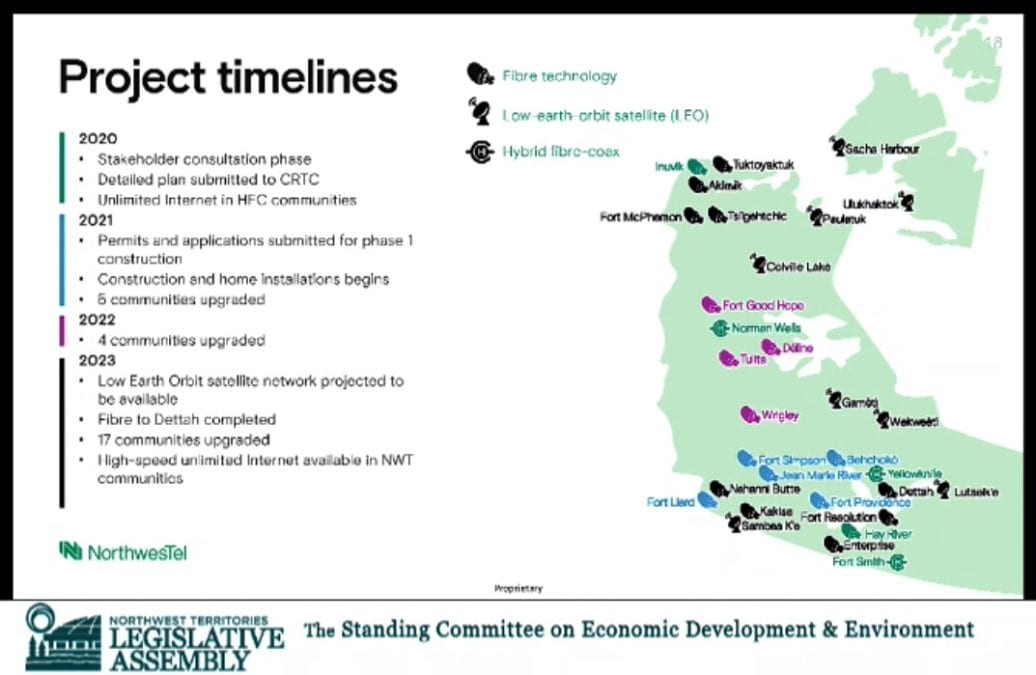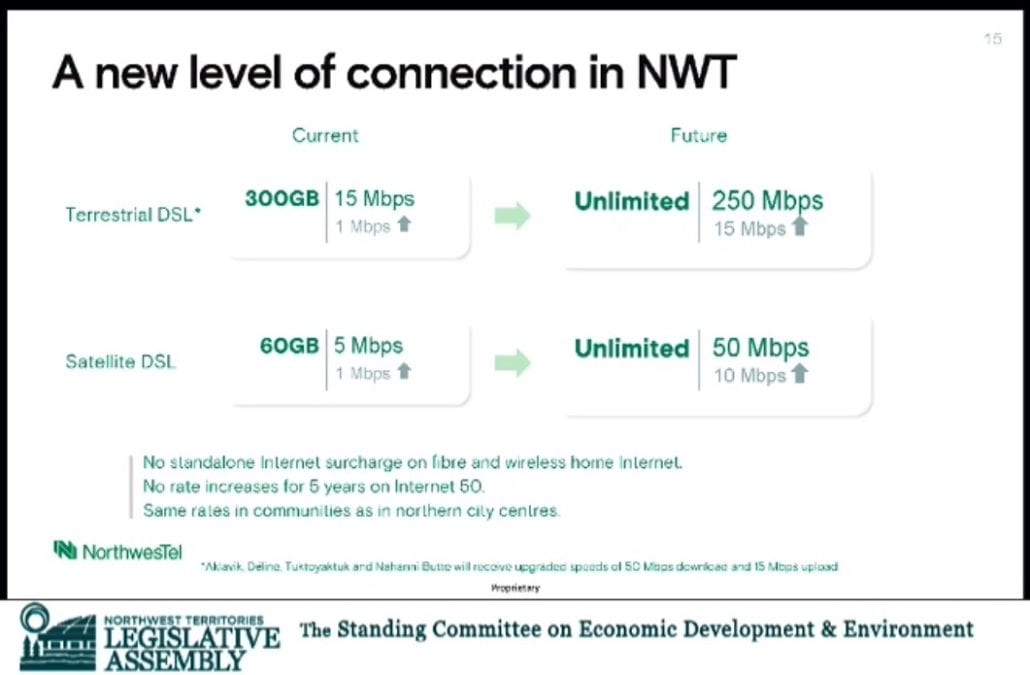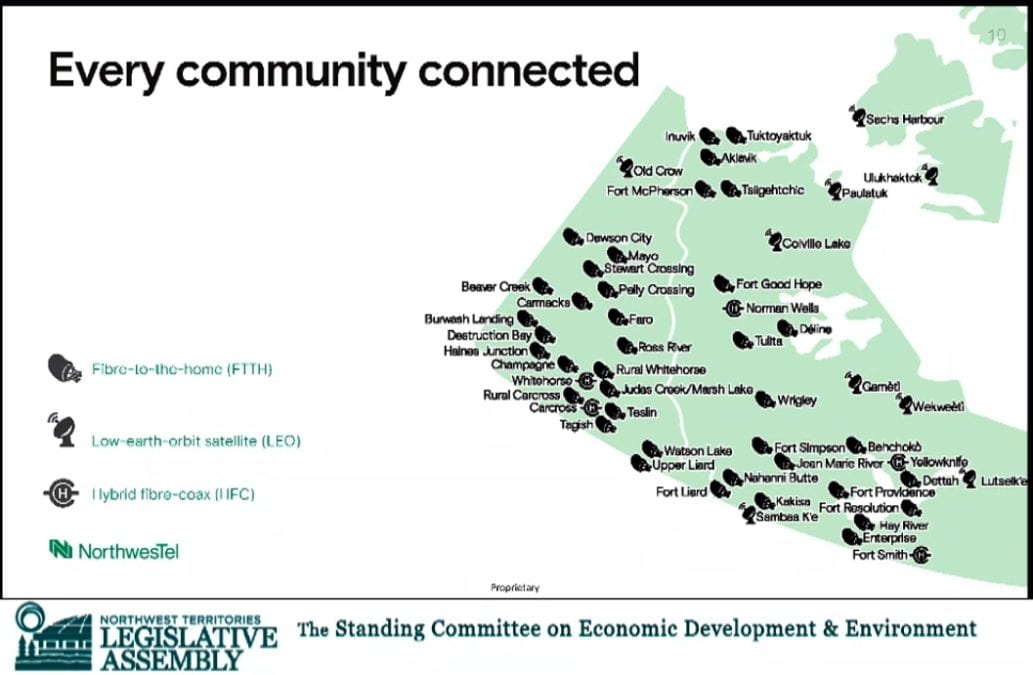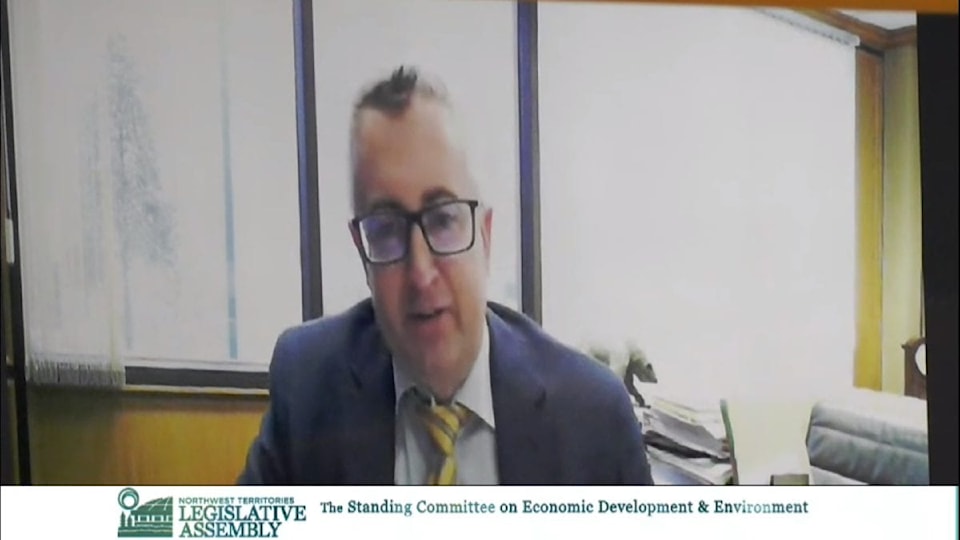Northwestel plans to expand unlimited internet service to almost all NWT communities through fibre-to-the-home or low-earth orbit (LEO) satellite connections by 2023, said company president Curtis Shaw in a GNWT meeting on Wednesday.
Shaw told the Standing Committee on Economic Development and Environment that LEO connections will be of particular benefit to remote communities like Sachs Harbour, Ulukhaktok, Colville Lake and Lutsel K'e because the satellites are relatively close to the earth and they reduce delay times when using the internet.
His presentation came almost one month after Northwestel rolled out unlimited internet packages for residential and business customers in Yellowknife, Fort Smith, Hay River and Norman Wells.
"There's significantly more bandwidth," Shaw said. "Today we're measuring our network in 10-30 Mbps (megabits per second). We're going to be able to deliver hundreds, if not thousands of Mbps to these communities over the next several years with LEO, and it's also lower cost."

GNWT images
LEO bandwidth would be transmitted to large dishes installed in the communities that would work in tandem to receive the signal and then distribute it to homes using wireless or fibre-optic connections.
The dishes would be covered in domes to protect them from the elements, Shaw added.
In terms of costs, rates would be pegged to the level in Yellowknife so that other communities don't pay more.
"We plan to bring every community up to same level of service over next three years," he said.
A standalone internet surcharge would be removed, a practice where users without phone lines must pay $20 extra for internet services.
"When this project is done that surcharge will go away. This will lower prices and increase speeds, and it gives customers an unlimited option," said Shaw.
The copper wire networks that serve most remote communities will be replaced with fibre optic networks.
The project is part of a proposal that Northwestel submitted to the Canadian Radio-Television and Telecommunications Commission (CRTC) this month.
Northwestel spokesperson Andrew Anderson said in an email that under the company's CRTC broadband fund proposal, every fibre-to-the-home or LEO satellite community can access Internet 50 for $110.95 per month (50 Mbps download, 10 Mbps upload, up to 300 GB) or Internet 50 with unlimited data for $160.95 per month.
Those prices will be fixed for five years and are the same as the ones currently in place in Yellowknife, Fort Smith, Hay River and Norman Wells, Anderson added.
The project is scheduled to proceed through three phrases until 2023, according to a Northwestel timeline.
Currently, Yellowknife, Fort Smith and Norman Wells are connected to hybrid fibre-coax networks, and Inuvik is linked to fibre.
Many remote communities, such as in the Sahtu and Tlicho regions are already connected to the fibre network, with the exception of Deline, Anderson said.
In 2021, there will be further expansion of fibre-to-the-home networks that will connect households in Fort Liard, Fort Simpson, Jean Marie River, Fort Providence and Behchoko.
In 2022, Wrigley, Tulita, Deline and Fort Good Hope will be linked to fibre.
In 2023, 17 other communities are scheduled to be connected to fibre and the LEO network and unlimited internet would be available for NWT communities. Dettah will have its community fibre connection set up in 2023 as well.

The costs of the expansion until 2023 will be covered under the $62.5 million Northwestel received from the CRTC's Broadband Fund, a $750-million pot to support internet access projects across Canada over a five-year period. The company topped up the Broadband Fund subsidies with its own private sector investment to put toward its internet projects.
Shaw's presentation comes just over a week since executives of NWT internet companies told a standing committee meeting that the GNWT needs to do more to foster competition in a telecommunications market that they said favours Northwestel.
Deh Cho MLA Ron Bonnetrouge asked Shaw about concerns raised in that meeting, such as third-party internet access (TPIA), which Northwestel allegedly isn't required to offer to competitors, and about working more closely with NWT internet companies.
However, Shaw responded that he didn't want to comment publicly on TPIA and said that any complaints related to those issues would be dealt with through the CRTC's review process.
Great Slave MLA Katrina Nokleby raised the issue of the alleged monopoly that Northwestel has in the North, and asked Shaw if there could be more partnerships with Northern businesses to provide last-mile internet connections.
"The market has been open to that since 2002," Shaw said. "We see competition for government services (and) for banks but not really in the residential market. There wasn't much competition back in 2012-2013 when we were rate regulated. That was the bargain we had in the markets we served. The competitive framework is evolving. We should look at the investment framework. We've put a lot investment into the ground and we're looking for partnerships. We're looking for ways to close the digital divide. It's going to be a balancing act."
Yellowknife North MLA Rylund Johnson pointed out to Shaw that Northwestel's map of Yukon shows a "rural Whitehorse" connection but not one for rural areas outside Yellowknife, such as along the Ingraham Trail.
"People on the Ingraham Trail are on Bell’s cell tower coverage, but if you’re not on Bell’s coverage you don't have internet access. I brought up this with the CRTC, too. They don't know that people live there," Johnson said. "When I look at your map I want to ask if you can add a rural Yellowknife component to your plans? More and more people are moving out of Yellowknife and they're dependent on the Bell tower."
Shaw admitted that the population coverage map isn't a "perfect depiction" of the North and said that in three years 90 per cent of homes will be covered.
"I can look at the Ingraham Trail," he said. "I know it’s not included as part of the Broadband Fund but if there’s significant population there it's something we’ll have to work with the federal government on and see about opportunities to close the digital divide either through next generation wireless or a fibre service."

On the issue of cellular phone service along highways, Frame Lake MLA Kevin O'Reilly said it can be a public safety concern and he asked Shaw what the company's plans are for more coverage.
Shaw explained that when exploring the installation of cellular towers it's best to build them near power lines or install the antenna on top of microwave towers.
"The biggest challenge with highway coverage is access to land and commercial power. If that doesn't exist that means we have to put in fuel tanks and have to fill them up twice a year with diesel. There are greenhouse gas emissions from that. And it could cost $100,000 a year to maintain a tower," he said. "Many of the federal programs have up-front capital to build a site but no financing to subsidize it. If a cell tower is built on the road to Fort Liard, there's little traffic on the road, there's no new revenue for anyone along the road, it's just a public safety cost."
